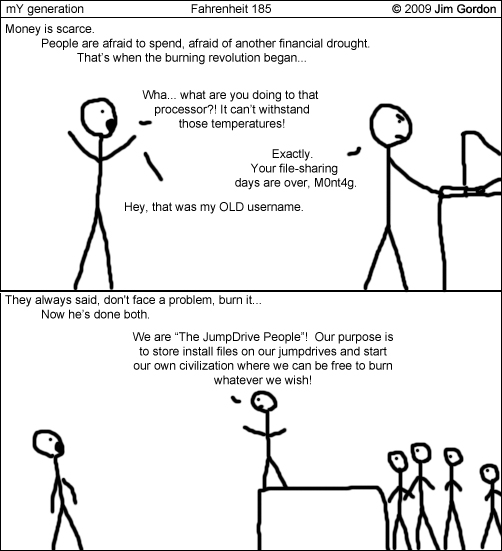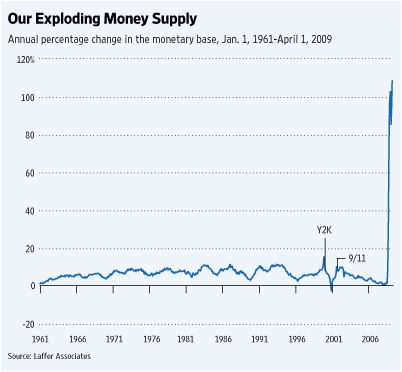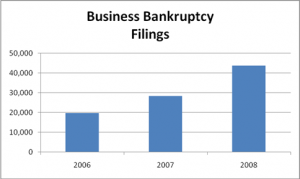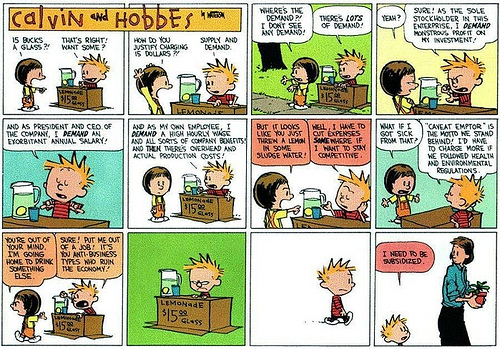|
|
|
Tuesday, November 17th, 2009
 Few things are constant, but management stupidity when it comes to retention is one of them. Few things are constant, but management stupidity when it comes to retention is one of them.
Before Wall Street pulled the rug out of under the economy global demographics made the need to cherish workers at all levels obvious.
Estimates of the national shortage run as high as 14 million skilled workers by 2020, according to widely cited projections by the labor economists Anthony P. Carnevale and Donna M. Desrochers.
Then came the downturn and executive retention stupidity is once again running rampant.
Two-thirds of executives at large companies were most concerned about losing Gen Y employees, while less than half of them had similar concerns about losing Gen Xers. nearly two-thirds of executives at large companies were most concerned about losing Gen Y employees, while less than half of them had similar concerns about losing Gen Xers.
The assumption is often that Gen Yers are the least loyal and most mobile, says Robin Erickson, a manager with Deloitte’s human capital division.
However, a companion survey of employees found that only about 37 percent of Gen Xers said they planned to stay in their current jobs after the recession ends, compared with 44 percent of Gen Yers, 50 percent of baby boomers and 52 percent of senior citizen workers who said the same.
Everyone surveyed worried about job security. Gen X and Gen Y were most likely to complain about pay. But a ”lack of career progress,” was by far the biggest gripe from Gen Xers, with 40 percent giving that as a reason for their restlessness, compared with 30 percent of Gen Yers, 20 percent of baby boomers and 14 percent of senior workers.
Gen Yers, meanwhile, were more likely than the other generations to cite ”lack of challenges in the job” as a reason they would leave, while baby boomers more often chose ”poor employee treatment during the downturn” and a ”lack of trust in leadership.”
Let me spell this out.
The economy will turn around.
The Boomers may stay in the workforce for now, but they will retire.
Gen Y is being held back because of the economy and may never catch up, certainly not fast enough to run American enterprise when the Boomers retire.
That leaves Gen X, which is being ignored.
Stupid attitudes towards employees is nothing new for the folks running companies, but this one is really going to come back and bite not just them, but our country’s competitiveness.
One can only hope that the stupidity is global, so we’re not the only ones dealing with it.
Your comments—priceless
Don’t miss a post, subscribe via RSS or EMAIL
Image credit: ZedBee|Zoë Power on flickr
Posted in About Leadership, Ducks In A Row, management, What Leaders DON'T | 8 Comments »
Sunday, August 2nd, 2009
See all mY generation posts here.

Posted in Culture, mY generation | No Comments »
Wednesday, July 22nd, 2009

Are you stressed yet? If not, this will do it!
Image credit: woodleywonderworks on flickr
Posted in Business info, Innovation, Wordless Wednesday | 1 Comment »
Tuesday, June 23rd, 2009
I’m traveling today, so I’d like you to welcome Miles Mochizuki.
Miles is a certified public accountant and principal at M. Mochizuki & Co. He is a CPA and MBA with more than 25 years of experience as a finance executive, auditor and consultant. He is the former CFO of several technology companies in Silicon Valley and a financing specialist who has arranged financing ranging from venture capital, bank and lease financing to multi-million dollar debt and equity offerings on Wall Street. His consulting clients include pre-IPO start-ups and established public companies. You can reach Miles at (925) 413-9198 and miles@mmochizuki.com
 Summary Summary
The recession and credit crunch have made cash a strategic asset. While debt and equity financing is still available, these sources of cash have become unreliable and difficult to tap, increasing the importance of operating cash flow.
Optimizing cash flow requires the close scrutiny of incoming and outgoing cash transactions and the implementation of credit, purchasing and strategic decisions that impact cash.
Simply put, maximize cash by spending wisely.
Reduce and Control Expenses
Headcount is a main driver of operating expenses. In good times as well as bad, organizational rightsizing is essential to effective cash management and controlling the company’s “expense burn.” Operating expenses are also strongly influenced by the company’s business model and strategic focus.
Here, the aim should be to reduce complexity by eliminating unprofitable products, markets and customers.
Reducing complexity will also simplify the purchasing process and reduce the required investment in inventory. Operating expenses such as travel and supplies should be examined and nonessential expenses eliminated. The feasibility of a negotiated rent reduction and other contract restructurings should also be considered.
The company should adhere to a regularly scheduled check run, typically once a week as a means of instilling discipline in the disbursements process. During this process, cash disbursements should be prioritized in order of importance to ongoing operations.
This usually means that payroll and essential vendor payments will have a high priority and will take precedence over other disbursements in the event that expected cash inflows do not materialize.
To the extent possible, disbursements should be timed to coincide with cash inflows so as to not unnecessarily deplete the company’s cash reserves.
Overall, the goal of managing cash inflows and outflows is to preserve and, optimally, increase the company’s cash balances so as to provide a financial buffer for operations. This conservative fiscal management will also result in presenting the company in its financial best light for the purposes of bank credit lines and other outside financing.
Weekly Monitoring of Cash Flow
Another component of effective cash management is the preparation and review of a weekly cash flow statement. This report should show in sufficient detail the items comprising cash receipts (cash sales, A/R collections, etc.) and cash disbursements (payroll, benefits, inventory purchases, etc.) for the current week and projected for the next 4 – 8 weeks.
This report should be prepared by accounting with input from sales and purchasing. It should be reviewed by the CFO or Controller, along with the current week’s A/R and A/P agings and check run. Follow-up items from this review should be discussed, as appropriate, with sales, operations and management.
Cash as a Strategic Asset
There is no question that in these uncertain times, cash and ready access to cash are strategically important and may make the difference between winning and losing. A company that manages its cash well will be in a strong position to weather the downturn and take advantage of the opportunities to strengthen its market share.
Conversely, in this economic environment poor cash management can quickly lead to insolvency and bankruptcy.
Image credit: svilen001 on sxc.hu
Posted in Business info, Strategy | No Comments »
Tuesday, June 16th, 2009
Actions have consequences, mostly unintended.
Ready, fire, aim.
In response—mostly—to the financial crisis, the US government has taken so many actions that the list is almost too long to chronicle here. To pick a few…
- The government has picked survivors in the banking industry.
- The government has picked survivors in the auto industry.
- The government has picked executives in many companies.
- The government has set compensation levels in many industries.
And the government’s intrusion into previously private enterprise sectors has only just begun.
Of course private enterprise has never been a model of virtue and discretion. But, just because private enterprise has executed a series of excesses, is it reasonable to assume that federal regulation will produce unalloyed goodness?
If executives in private enterprise cannot foretell catastrophes ahead, is it reasonable to assume that those same executives, when working on behalf of the federal government, will have better foresight?
Massive Actions, Unintended Consequences
The economy is in uncharted territory. This is the first major crisis of the integrated, global economy. It simply has too many moving parts for any individual or organization to identify all the inter-relationships, much less to forecast the results of all those interconnections. The chart below makes the point exquisitely.

Historically the money supply has grown by 2-7% annually, with spikes prior to Y2K and following 9/11. In the past nine months, the Fed has increased the money supply by over 100%, almost ten times greater than the largest previous increase, during Y2K. The Fed might argue that this increase was needed to offset the loss of a comparable amount of bank lending, when credit dried up in the past year.
But how and when does the Fed unwind this massive increase? What are the long-range consequences of this action?
At the moment, no one can guess. However, we can be certain that many of the consequences will be significant, unforeseen, and unintended.
Transparency – The Only Cure for Unintended Consequences.
The Federal government now controls almost 25% of all domestic economic activity, not to mention 100% of the money supply. We need much more transparency, particularly with government sponsored enterprises such as Fannie Mae and Freddie Mac.
Recently our culture has cheapened transparency to the cliché “full disclosure…” after which the author lists some relationship, often trivial.
The US government pumped over $170 billion into AIG late last year, to prevent its collapse. This expense received very little exposure, either from the press or by the Treasury Dept. execs who made the “investment.” Where did this $170 billion go? Why was this expense necessary?
Neither elected congress people nor Presidential staff exhibited any curiosity or outrage over this “investment.” However, when AIG paid out $165 million in bonuses—only 1/1000 of the amount the Treasury Dept. had spent a few months earlier—elected officials went into hysterics. Selective transparency is no transparency at all.
“Sunshine is the Best Disinfectant.” –Supreme Court Justice Louis Brandeis
Meaningful transparency can have considerable impact. Witness the recent publishing of the expense accounts of British Members of Parliament.
In the US, the Federal Election Commission (FEC) regulates campaign contributions. Of course every politician running for office has thoroughly computerized records of donors and amounts and the FEC requires that every candidate report all donations to the FEC. That information might be interesting to voters making voting decisions. But candidates provide those reports to the FEC in thick, printed volumes, specifically to delay the FEC in compiling the results. As a result the FEC finally publishes the donation reports months after the elections are done.
Follow the Money—Post Everything on the Internet
With the expansion of the government into finance, autos, energy, and insurance, as well as health care, public disclosure is critical if our economy is to respond positively. Encourage your elected representatives to post budgets, and expenses on the internet.
Over time, we can recapture our democracy.
Posted in Politics | 2 Comments »
Tuesday, May 19th, 2009
Possibly the most difficult question for any is business:
“Is it time to pull the plug?”
Business Bankruptcies up over 100% since 2006
In this difficult economic environment, many businesses are answering that question simply, “yes.” As the chart below shows, business bankruptcy filings grew dramatically in 2008, up over 100% from 19,695 in 2006 to 43,546 in 2008.

This chart is deceptive, because the average annual number of business bankruptcy filings for the 28 years 1980-2008 is 52,667 and the number of filings in 2005 was 39,201. So the 43,000 filings in 2008 are 20% below the long-term average and just a little above the number in 2005. But, regardless of the long-term average, the short-term trend is up over 200%.
Time to Pull the Plug on My Business?
Setting aside statistics, the question at hand is real, personal, and immediate for many small business owners. As a professional business consultant, I work with several clients struggling with this question.
One of my clients generates approximately $3,000,000 in revenue and supports 25 employees. For the past two years, this company’s revenue has remained flat, with annual losses of $250,000 or so. This year revenues have declined and the owner has kept the monthly losses to $20,000 by reducing expenses. So far, so good, right?
Will the situation improve in the near future? Is a turn-around in sight with just a little more patience and persistence? When does persistence become stubbornness? When is it time to pull the plug? How do you know? Forgive this barrage of questions—this is an extremely difficult, emotional question for a business owner.
What Are Your Choices?
As a business unit manager, you have the opportunity and responsibility to make major changes in your business. 2% solutions don’t count.
What few significant changes can you make to improve the problems facing your business?
- Eliminating People Means Eliminating Work. You simply cannot eliminate people and leave the workload unchanged. How can you reorganize your business to reduce the work? Can you automate or outsource back-office services or sales? Can you move more functions online? Can you move your customers to self-service online? Can you use online order / payment to simplify the sales and collection processes?
- Don’t Eliminate Products. Eliminate Production Costs. Can you shift inventory and fulfillment services to suppliers or third parties?
- Don’t Eliminate Value. Eliminate Overhead. Do you need all the office space, telephones, equipment, and software? Eliminate, reduce, or find it for free.
- Grow Revenues. Be careful here, as increasing revenue is extremely difficult, especially in this recession economy. It’s easy to forecast big growth, only to be surprised three months later when the growth has not appeared on schedule. First, find a few customers for your services, and then forecast the growth based on their orders.
You Already Know the Answer
Three business aphorisms provide some insights into this question:
- The universe rewards action.
- Ready, fire, aim.
- Follow the money.
Taken as a set, they offer a road map to making this difficult decision.
If your business is struggling, then do something! The business (universe) will respond to your actions.
If the business situation is getting worse, you have limited time and budget to make meaningful changes. This is not the time to be shy. Take some dramatic action. That’s the “ready, fire” advice. Observe the result. Based on the result, quickly adjust your actions to improve the outcome (aim).
Finally, follow the money to your desired outcome. You know your budget for time and money. When either one runs out, you lose your freedom of action. Take action now, while you still have freedom to choose.
The biggest obstacles to meaningful business change are usually not intellectual understanding of the problem, or a lack of options, but emotion and fear.
For instance, most business owners truly care for their employees so layoffs are difficult. “What will my employees do without this job? How will they survive?” If you are considering major changes in business direction, fear raises similar questions about you; “How will my company survive if I make this change? What will I do with my life if my company fails, or if I have to shut it down?”
Together, emotional attachment and fear of the future create a paralysis, even in the face of clear impending disaster. When you wake up at 2 AM, what is on your mind? If you can get past the emotion and fear, I believe you already know the answer. “Don’t go wobbly,” as Margaret Thatcher famously advised George Bush senior when he was preparing for the first Iraq war. “I just don’t know,” is a cop-out.
What is Your Biggest Fear?
If your company is losing money each month, you must make changes. In this economy, your business will not get better by itself. What is the single change you fear the most?
Turn off the computer, put down the cell phone. Be still for a few moments, sitting with your fears and emotions. What is your biggest fear? Go there. Do it.
Wishing you the courage to make the difficult decisions,

Posted in Strategy | No Comments »
Wednesday, May 13th, 2009
Note: this Calvin dates back about 15 years. (<sigh> I still miss Calvin!)

Be sure to check out yet another bad culture
Image credit: feloniousrambler on flickr
Posted in Business info, Just For Fun, Wordless Wednesday | No Comments »
Tuesday, May 12th, 2009
In previous posts I shared my views regarding the shape of the recovery and shape of employment in the future.
The President and Congress have told us, this recovery will also cost a few trillion, so the open question is: how the value of the dollar will change in the months and years ahead? Deflation, inflation, or both?
 The following is what I think may happen. The following is what I think may happen.
First, the Fed Rebuilds the Banks
According to the Fed, total mortgage debt exceeded $14 Trillion as of Dec. 31, 2007.The best estimate is that 10-20% of that debt must be written off due to the drop in house values. That’s $1.4-$2.8 Trillion. Assuming US banks hold only 50% of that debt, that’s $700 Billion to $1.4 Trillion that needs to be removed from their balance sheets for mortgage debt alone. That does not include credit card debt, auto loan debt, student loans, or business debt. The Fed will have to print enough funds to cover the debt, lending to the chosen banks. Those funds will not provide any stimulus, as the dollars will simply re-establish the reserve levels that banks are legally required to carry.
Second, Consumers Start Saving—Near Term Deflation
Of the US $14 Trillion GDP, 70% ($10 Trillion) is driven by consumer spending. If consumers increase their savings rate from -2% to +5%, another $700 Billion (7% of $10 Trillion) will be removed from the economy, creating an additional 5% drop in the GDP. In the short term we will have deflation, driven by declining demand. Sure enough, that’s just what has happened in the past four quarters.
Third, the World Redeems Dollars—Long Term Inflation
With over $7 Trillion dollars flowing internationally as global reserves outside the US ($2 in China, $2 in Japan, $2 in OPEC, and $1 in Europe), plus the $7 Trillion the Fed has already printed in the past year, over $14 Trillion (1x GDP) in cash is beyond the control of the US.
Sometime in 2010-2011, the US may see currency deflation as other countries spend their dollar reserves to dig out of their own recessions. Remember that we produce very little of our own hard goods, They come from China, Japan, Korea and other countries. We buy energy from OPEC. If the dollar drops vis-à-vis Korea, Japan, China, and OPEC, then the US may see an increase in the price of hard goods and energy.
Granted, any price rise will be moderated by the domestic drop in consumption, but the US no longer controls the price of global goods, services, and energy. The US share of global commerce is 23%, and declining. Global consumption will increase, regardless of the US. Prices will rise, and the dollar will likely decline against other currencies—a one-two punch for the US.
What Do You Think?
What is your forecast for GDP and deflation/inflation? How does it affect your business planning?

Posted in Business info, Strategy | No Comments »
Tuesday, April 21st, 2009
Many economic pundits are predicting the end of this economic meltdown (see previous post). Chalk those predictions up to the optimism of springtime and the need to fill a news cycle.
 While rates of decline for various economic indicators may be decreasing, the excesses that created this meltdown will take years to work through. The ham-handed responses by government and many businesses will only delay the eventual recovery. This is only a break in the winter weather. While rates of decline for various economic indicators may be decreasing, the excesses that created this meltdown will take years to work through. The ham-handed responses by government and many businesses will only delay the eventual recovery. This is only a break in the winter weather.
But even as the economic meltdown is only now approaching its nadir, a few new businesses may find this to be a fertile time to set up shop.
Consider the single greatest expense and challenge of most new businesses – finding and attracting talented workers, trained and immediately available for interesting work.
Currently the US economy provides 155 million jobs. This meltdown has reduced employment through five distinct mechanisms shown in the table below:
|
Type of Employment Reduction
|
Description
|
Number of Workers (millions)
|
Percent of the Workforce
|
|
Unemployed
|
Recent filers for unemployment
|
13.2
|
8.5%
|
|
Underemployed
|
Working part-time while seeking full-time employment
|
9
|
5.8%
|
|
Reduced Hours
(Furlough)
|
Full-time workers working less than full-time
|
2.7
|
1.7%
|
|
Discouraged Workers
(Marginally Attached)
|
Unemployed for over one year.
|
2.1
|
1.0%
|
|
Non-starters
|
Recent college graduates who have not found permanent employment
|
0.18
|
0.1%
|
|
Totals
|
|
27.18
|
17.1%
|
Given that the measured statistics are usually undercounts and that these unemployment/underemployment numbers will grow in the next 12 months, likely over 32 million workers (over 20%) in the US will have talents and time available to participate in another business.
For many companies, payroll costs represent over 65% of total expenses. For new ventures, personnel costs can be much larger, up to 90% of expenses. In this environment, many workers are searching for work.
New ventures traditionally offer below-market compensation for their workers. However, they offer other significant benefits.
Typically, new ventures offer broader scope in each job, better growth opportunities, ability to make large, direct, measurable contributions to the organization, and the enthusiasm of working in a small, close-knit team. Some new ventures offer profit participation or stock options. For unemployed or underemployed workers, these benefits can be significant, even when the cash compensation is low.
Technology and the recession have dramatically reduced other business operating costs. The cost of computers, phone systems, and tele-conferencing have dropped. Office space is cheaper, and home-based employees can cut that cost even further. Travel, where necessary, is cheaper than any time in the past ten years.
Even without easy availability of capital for start-ups, this recession may offer fertile ground for new ventures and with the added benefit of retaining far more of the equity.

Posted in Business info, Compensation, Hiring, Innovation, Motivation, Retention, Strategy | No Comments »
Tuesday, April 14th, 2009
 Economic pundits, eagerly searching for signs of the recovery, are grasping at almost anything. “The rate of decline has slowed.” “Unemployment has stabilized.” “The cardboard box index has bottomed out.” And the shape of the recession and recovery has been predicted to be a V, W, L, or even a double-bounce W. Economic pundits, eagerly searching for signs of the recovery, are grasping at almost anything. “The rate of decline has slowed.” “Unemployment has stabilized.” “The cardboard box index has bottomed out.” And the shape of the recession and recovery has been predicted to be a V, W, L, or even a double-bounce W.
I think they’re all wrong.
The old economy will never come back.
This economic meltdown is much like a forest fire. After the fire burns itself out, the storm may be over, but the burn area is fundamentally changed. It does not “bounce back.” It starts at a different place. Sometime in 2010, the economy will stabilize, but it will not “come back.” We will go forward from a fundamentally different position. This new starting point will reflect the impact of deep, long-term, global trends in the nature of work, the value of the dollar, and our relationship to our government. The current recession is a convenient marker to recognize these trends.
Work Is Changing
The nature of employment will continue to change. The United States will continue to shift to a “just-in-time,” service-based workforce. The manufacturing sector will continue its decline, from 29% of GDP in 1950 to 15% in 2000 (see analysis by Dr. Mankiw). It will drop below 10% by 2010. You can construct your own labor trend at indeed.com. ( This website is a fascinating example of the business of data, which we discussed in the last three posts.)
Many new service-sector workers will be involuntary. Growing unemployment and under-employment in the United States (which will exceed 15% this year) is driving many people into self-employment as service workers. An analysis of Japan’s Lost Decade by Tom Coyner, long-time resident of Japan and Korea, provides one instructive example of this phenomenon, and some associated risks.
These new service sector workers will be driven to a “do-it-yourself” model for almost everything. They will have to provide their own health care plan, retirement plan, office arrangement, and business planning. Many of these workers will be home-based, with little differentiation. The most common product/pricing model will be piecework, with unit pricing based on the alternative of being completely idle. Ironically, one result will be the re-integration of work and home life.
Entrepreneurship is Changing
Investment capital will no longer be available for any but the most solid businesses; and the vast majority of these newly-independent service workers do not have plans to build large businesses. As a result, the successful ones will exhibit four common, positive characteristics:
Local—In a global world, being present still counts. A local service provider who can show up in person has a distinct advantage. In addition, some services simply cannot be outsourced. When your car is broken or your roof leaks, you need a local service person. For locally-based services we may see an increase in a local, personal relationship with service providers.
Immediate—Without investment capital to fund long-term research and development, independent service-providers and small businesses must focus on services that provide immediate value. The “cash-to-cash” cycle must be less than one pay period. Fortunately, credit/debit cards and other immediate payment methods support this trend.
Information-based—Information will provide significant improvements in service quality and competitive differentiation. For instance, simply finding a customer is difficult and expensive. Irritating prospects with unnecessary and unwanted sales promotions is also costly. Successful service providers will use information to target customers on a “just-as-needed” basis.
Green—Setting aside the discussion of whether the earth is warming or whether green is good, government policies will reward green activities preferentially. Independent service providers will offer green services or enhance green aspects of their existing services.
Start-Ups Will Explode in Unlikely Niches
The availability of many talented people and the flexibility of independent service providers will fuel new start-ups. While these may not completely replace the loss of investment capital, they will certainly provide an alternative path of low-cost labor for new businesses. The change may be refreshing, for us individually, and for our economy.
This is perhaps the greatest unknown—how much will individual creativity and inspiration replace financial engineering.
I am hoping for a few delightful surprises ahead.

Posted in Business info, Compensation, Strategy | 1 Comment »
|
 Subscribe to
Subscribe to
MAPping Company Success
About Miki 
Clarify your exec summary, website, etc.
Have a quick question or just want to chat? Feel free to write or call me at 360.335.8054
The 12 Ingredients of a Fillable Req
CheatSheet for InterviewERS
CheatSheet for InterviewEEs™
Give your mind a rest. Here are 4 quick ways to get rid of kinks, break a logjam or juice your creativity!
Creative mousing
Bubblewrap!
Animal innovation
Brain teaser
The latest disaster is here at home; donate to the East Coast recovery efforts now!
Text REDCROSS to 90999 to make a $10 donation or call 00.733.2767. $10 really really does make a difference and you'll never miss it.
And always donate what you can whenever you can
The following accept cash and in-kind donations: Doctors Without Borders, UNICEF, Red Cross, World Food Program, Save the Children
*/
?>About Miki
About KG
Clarify your exec summary, website, marketing collateral, etc.
Have a question or just want to chat @ no cost? Feel free to write
Download useful assistance now.
Entrepreneurs face difficulties that are hard for most people to imagine, let alone understand. You can find anonymous help and connections that do understand at 7 cups of tea.
Crises never end.
$10 really does make a difference and you’ll never miss it,
while $10 a month has exponential power.
Always donate what you can whenever you can.
The following accept cash and in-kind donations:
|
 Few things are constant, but management stupidity when it comes to retention is one of them.
Few things are constant, but management stupidity when it comes to retention is one of them.










 The following is what I think may happen.
The following is what I think may happen.
